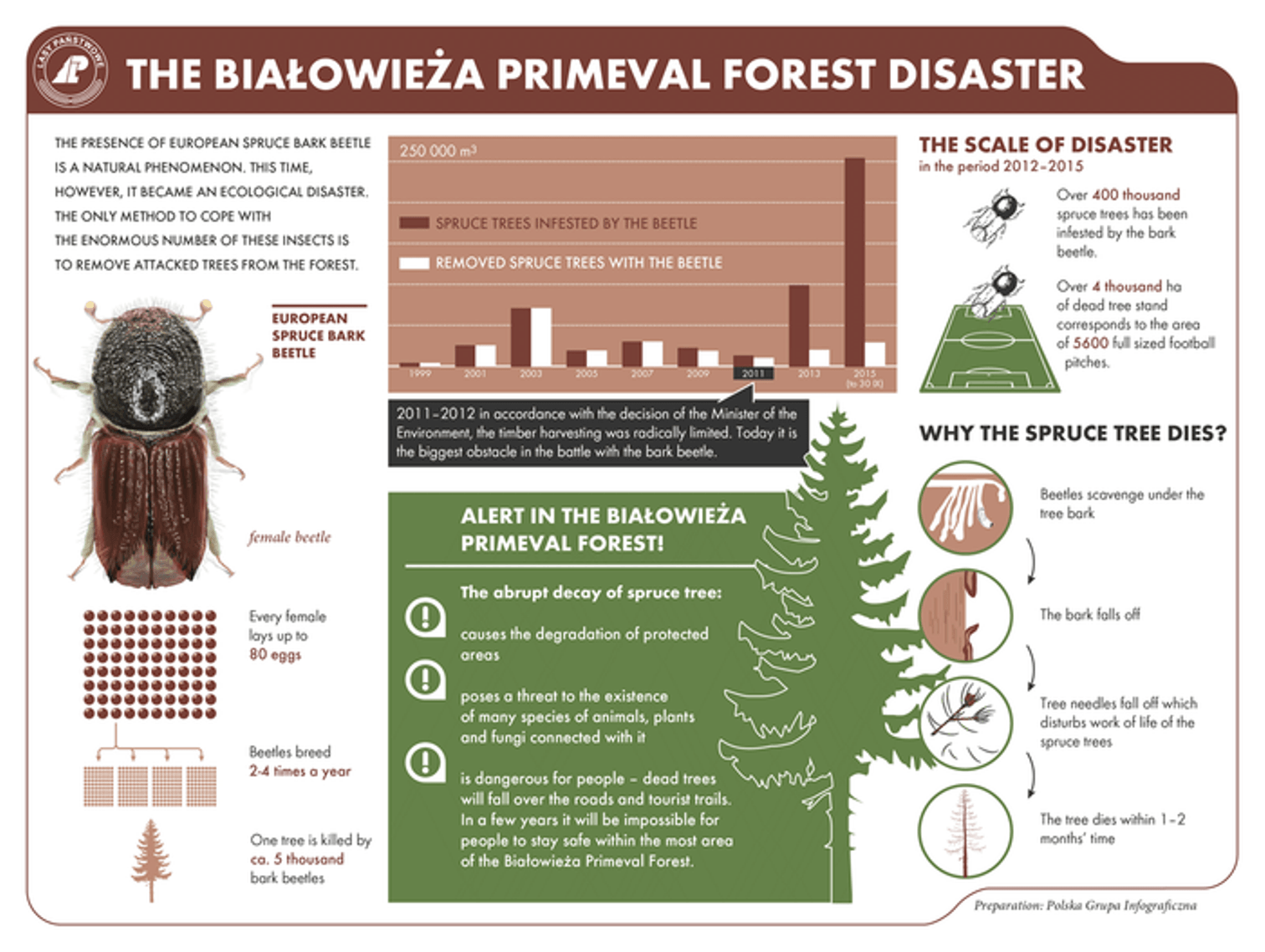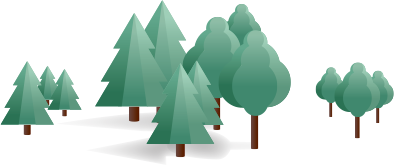Lasy Państwowe (Poland): Spruce bark beetle in the Białowieża Primeval Forest

photo: Marek Matecki/CILP
What you should know about the Białowieża Primeval Forest and the European spruce bark beetle that attacks it.
What is happening in the Białowieża Primeval Forest?
Spruce trees that are attacked by the bark beetle massively die in the Białowieża Primeval Forest. This is the biggest reported invasion of bark beetle since many decades. Until this day ca. 500 thousand trees, within the area of three forest districts, have fallen prey to this insect. It means that 4 thousand out of 52 thousand ha of tree stands, that are looked after by foresters, are dead. Trees die also in reserves located within the area maintained by the State Forests and in the Białowieża National Park.
The bark beetle scavenges on limber under the tree bark which leads to tree’s death even within one month. Normally the insect attacks old and weakened trees, however, this time its gradation (i.e. count increase) is so big, that even young, healthy and strong trees fall prey to the insect. It is important to remember that the bark beetle already has begun to attack other tree species, for example pine tree and larch.
Why do foresters want to cut down attacked spruce trees?
Because it is the only effective way to limit the extent of bark beetle gradation when it attacks on such a large scale. Trees that are already colonized by the bark beetle are cut down and removed from the forest in order to disable the transfer of the insects to healthy tree barks. Foresters want to leave the majority of those dead trees that are no longer inhabited by the bark beetles until their natural decay.
The bark beetle gradation appears periodically, irregular in dimension, yetuntil now it has always been under control because foresters have been removing attacked trees from the forest. However, in the period 2011-12 the Ministry of the Environment limited the timber harvesting in forest districts and in consequence it was impossible to stop the gradation expansion – the number of trees colonized by insects grows rapidly.
Białowieża Forest Districts of the State Forests want to obtain consent from the Minister of the Environment to cut down spruce trees due to three reasons:
- In order to limit the gradation; the bark beetle spread will continue unless the attacked spruce trees are logged and removed from the Białowieża Primeval Forest (spruce tree constitutes 30 % of the Białowieża Primeval Forest tree stands). Current bark beetle gradation also endangers precious habitats protected under law pursuant to Nature 2000, for example subcontinental oak-hornbeam forest – foresters are responsible for its preservation.
- for safety reasons: dead oak trees within few years after death fall over. If they are not felled, a/o along roads and trails, they will pose threat to people. As a consequence it would be necessary to impose exclusion order, prohibiting from entering to the Białowieża Primeval Forest.
- Only the logging of dead spruce trees will enable to introduce renewals (natural and man-made), which in several dozen years will erase the bark beetle trail. Without the human help, the restoration of the Białowieża Primeval Forest would last much longer. Where possible, foresters want to initiate natural renewals. Where it is impossible to use natural measures, foresters will conduct man-made renewals – foresters will seed cuttings of various forest’s species that come from seeds obtained from specially selected trees from the Białowieża Primeval Forest.

Why don’t foresters want to leave spruce trees on their own, as ecologists propose?
Ecologists claim that the bark beetle plague is a natural phenomenon and the nature will cope with it on its own. They want to let the bark beetle spread to other spruce trees, so that the spruce trees will fall over and the forest will renew on its own. The only problem is that the current bark beetle gradation, has not be present on such a large scale for a very long time. The insect will destroy the whole area of the Białowieża Primeval Forest. In a few years’ time it will be hazardous to enter such area because of dead trees fall-over. Expansive grass (for example small reed) will replace trees when they will already have fallen over – this view is also shared among ecologists. These grass create thick and dense bark layer that will make the fragile tree seedling impossible to break through it. In that way for decades before trees battle the grass, vast parts of the Białowieża Forest would resemble steep, not a forest that we are used to know.
Therefore, according to foresters, ecologists propose conducting a hazardous experiment on the Białowieża Primeval Forest. Similar experiments are being conducted by Czechs within the area of destroyed by the bark beetles Šumava National Park, and Germans in Bavarian Forest National Park. Moreover, Polish ecologists want to conduct this experiment within the whole area of the Białowieża Primeval Forest – the most precious forest in Europe. Who will take responsibility if the experiment ends up in failure? The answer is – foresters, by virtue of the law. In similar disasters human has always helped the nature in order not to irreversibly lose precious animal and plant habitats.
Secondly, the obligation of conducting active forest protection, in this case active fight against bark beetle, is imposed on foresters by regulations, precisely the Forest Act. The Art. 9 says that in order to ensure the general forests protection, their owners (in case of The State Forests foresters that manage forests on behalf of the Treasury) are obliged to: structure the balance within forest ecosystems, increase the natural resistance of tree stands, and especially: to prevent, detect and combat the spread and appearance of harmful organisms. Another Article says that in case of occurrence of harmful organisms to the extent that it endangers the persistence of tree stands, the forest manager performs combative and protective treatments.
Where will foresters perform logging?
It needs to be emphasized that the foresters’ demand involving increase in logging does not concern the area of the Białowieża National Park. It concerns a small part of timberlands that constitute fragment of the Białowieża Primeval Forest, which covers total area of 150 thousand ha, and 65 thousand ha lies on the Polish side. The State Forests maintain the area of ca 50 thousand ha of the Białowieża Primeval Forest, and tree stands of the Białowieża Forest District, that tries to obtain consent to log attacked trees, constitute 12 thousand ha. However, major part of these grounds cover reserves and hydric and pioneer habitats excluded from usage. Therefore, dead spruce trees would be logged only within other grounds – total 7 thousand ha that constitute ca. 5 percent of the whole Białowieża Primeval Forest area.
Can bark beetle gradation be stopped?
It is impossible to completely stop the gradation of bark beetle, because it would require logging all attacked spruce trees, also those that grow on protected grounds including the National Park grounds. Moreover, logging shall take place before spring comes when insects start scavenge again. However, even logging of the part of attacked spruce trees that grow on the area managed by the State Forests, will reduce the spread of the plague to other tree stands. It is essential to remember that bark beetles that scavenge on one tree are able to attack 30 other trees, and these attacks may occur four times a year.

How much money will the State Forests earn on the spruce tree logging?
The Browsk, Hajnówka and Białowieża Forest Districts are profitless. All 430 Forest Districts of the State Forests contribute to forestry fund, that finances such deficient units as Białowieża Forest Districts. When foresters ask for introducing an amendment to the forest management plan, they have in mind the good of the Białowieża Primeval Forest, not the economical income. Money, that must be spent by the State Forests on the dead tree logging, removing them from tourist traces and carting those trees that are inhabited by insects and pose a real threat to other trees, will be equal to the revenue from sales of colonized by bark beetle timber, that can be used only as a firewood. Dead trees that are abandoned by bark beetles will be left in the Białowieża Primeval Forest until their natural decay. Only a part of them will be logged and pulled away – those that grow by tourist traces or roads and pose threat to people.
Will foresters log spruce trees ‘to the core’?
Not in the vast majority. They will log only dead spruce trees or those colonized by the bark beetle, posing threat to a/o people. At the worst, in those areas where trees that grow side by side are lodged on a bigger scale, the so called nests will be created. In the majority of cases only single trees will be lodged. It is important to remember that all areas, where the logging will take place, are going to be renewed: where it is possible – in a natural way, in other areas – with human help by planting new trees.

photo: Michał Wojcieszkiewicz/december2015
Is Białowieża Primeval Forest really primeval?
Forest that was not modified by a human can be called primeval. Natural forest, on the other hand, is a forest that was also not planted by a human, however, it may be used in a moderate degree. There is a dispute that concerns whether within the area of the Białowieża Primeval Forest can be found fragments of primeval forest, because human has been using it for a thousands of years. The most similar to primeval forest is the 5 thousand ha area within the territory of the Białowieża National Park, where logging has been forbidden since tsarist times because it was a game refuge.
The Białowieża Primeval Forest, within the territory maintained by the State Forests and thanks to the sustainable forest management, had survived in its natural state. For example, within the territory of the Białowieża Forest District one – third of the Białowieża Primeval Forest area constitute reserves. Another 34 percent of the District’s territory, where trees are also not logged, constitute tree stands considered to be over 100 years old. Within the remaining one – third of the district’s forests, about 25 percent of tree stands, that constitute usage hydric and pioneer habitats, are excluded from usage. However, even the remaining 2800 ha of the Białowieża forests are managed in a different way in comparison with the rest of the country’s forests. For example, within the territory of the closes national park there are not performed clearcut harvests, heavy equipment is not used and the renewal is only natural. Moreover, within the area of all three Białowieża Primeval Forest districts, the level of logging is much lower than within other forest districts in Poland.
Why the whole area of the Białowieża Primeval Forest was not integrated into the national park?
Foresters are not a party in regard to extending the Białowieża National Park. This decision rests with the Minister of the Environment. The State Forests, just as the Białowieża National Park, are subordinate to the Ministry of the Environment and are to implement national forest policy. It is evident that every decision made by the Ministry is respected by us and the State Forests shall conform to it.
However, we believe that the State Forests have been maintaining the Białowieża Primeval Forest area successfully for over 90 years. Demands regarding integrating these grounds to the national park are the best evidence. They stem from the fact that these forests were, and after 90 years still are highly biodiversified.
Published 13/04/2016, Brussels

